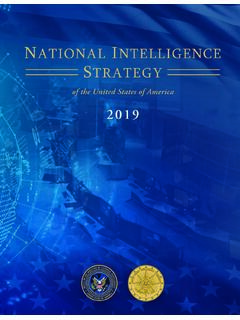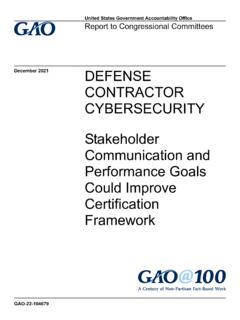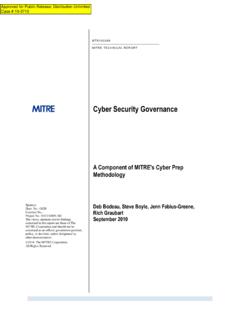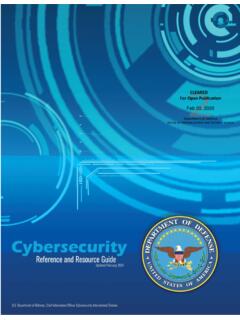Transcription of Cyberwarfare and Cyberterrorism: In Brief
1 Cyberwarfare and cyberterrorism : In Brief Catherine A. Theohary Specialist in National Security Policy and Information Operations John W. Rollins Specialist in Terrorism and National Security March 27, 2015 Congressional Research Service 7-5700 R43955 Cyberwarfare and cyberterrorism : In Brief Congressional Research Service Summary Recent incidents have highlighted the lack of consensus internationally on what defines a cyberattack, an act of war in cyberspace , or cyberterrorism . Cyberwar is typically conceptualized as state-on-state action equivalent to an armed attack or use of force in cyberspace that may trigger a military response with a proportional kinetic use of force. cyberterrorism can be considered the premeditated use of disruptive activities, or the threat thereof, against computers and/or networks, with the intention to cause harm or further social, ideological, religious, political or similar objectives, or to intimidate any person in furtherance of such objectives.
2 Cybercrime includes unauthorized network breaches and theft of intellectual property and other data; it can be financially motivated, and response is typically the jurisdiction of law enforcement agencies. Within each of these categories, different motivations as well as overlapping intent and methods of various actors can complicate response options. Criminals, terrorists, and spies rely heavily on cyber-based technologies to support organizational objectives. Cyberterrorists are state-sponsored and non-state actors who engage in cyberattacks to pursue their objectives. Cyberspies are individuals who steal classified or proprietary information used by governments or private corporations to gain a competitive strategic, security, financial, or political advantage.
3 Cyberthieves are individuals who engage in illegal cyberattacks for monetary gain. Cyberwarriors are agents or quasi-agents of nation-states who develop capabilities and undertake cyberattacks in support of a country s strategic objectives. Cyberactivists are individuals who perform cyberattacks for pleasure, philosophical, political, or other nonmonetary reasons. There are no clear criteria yet for determining whether a cyberattack is criminal, an act of hactivism, terrorism, or a nation-state s use of force equivalent to an armed attack. Likewise, no international, legally binding instruments have yet been drafted explicitly to regulate inter-state relations in cyberspace . The current domestic legal framework surrounding Cyberwarfare and cyberterrorism is equally complicated.
4 Authorizations for military activity in cyberspace contain broad and undefined terms. There is no legal definition for cyberterrorism . The USA PATRIOT Act s definition of terrorism and references to the Computer Fraud and Abuse Act appear to be the only applicable working construct. Lingering ambiguities in cyberattack categorization and response policy have caused some to question whether the United States has an effective deterrent strategy in place with respect to malicious activity in cyberspace . Cyberwarfare and cyberterrorism : In Brief Congressional Research Service Contents Introduction .. 1 The Cyberwarfare Ecosystem: A Variety of Threat Actors .. 2 Cyberwarfare .. 4 Rules of the Road and Norm-Building in cyberspace .
5 4 cyberterrorism .. 9 Use of the Military: Offensive cyberspace Operations .. 10 Contacts Author Contact 12 Cyberwarfare and cyberterrorism : In Brief Congressional Research Service 1 Introduction Cyberattack is a relatively recent term that can refer to a range of activities conducted through the use of information and communications technology (ICT). The use of distributed denial of service (DDoS) attacks has become a widespread method of achieving political ends through the disruption of online services. In these types of attacks, a server is overwhelmed with Internet traffic so access to a particular website is degraded or denied. The advent of the Stuxnet worm, which some consider the first cyberweapon, showed that cyberattacks may have a more destructive and lasting effect.
6 Appearing to target Iran, Stuxnet malware attacked the computerized industrial control systems on which nuclear centrifuges operate, causing them to self-destruct. Recent international events have raised questions on when a cyberattack could be considered an act of war, and what sorts of response options are available to victim nations. Although there is no clear doctrinal definition of Cyberwarfare , it is typically conceptualized as state-on-state action equivalent to an armed attack or use of force in cyberspace that may trigger a military response with a proportional kinetic use of force. cyberterrorism can be considered the premeditated use of disruptive activities, or the threat thereof, against computers and/or networks, with the intention to cause harm or further social, ideological, religious, political or similar objectives, or to intimidate any person in furtherance of such objectives.
7 Cybercrime includes unauthorized network breaches and theft of intellectual property and other data; it can be financially motivated, and response is typically the jurisdiction of law enforcement agencies. The cyberattacks on Sony Entertainment illustrate the difficulties in categorizing attacks and formulating a response policy. On November 24, 2014, Sony experienced a cyberattack that disabled its information technology systems, destroyed data and workstations, and released internal emails and other materials. Warnings surfaced that threatened 9/11-style terrorist attacks on theaters scheduled to show the film The Interview, causing some theaters to cancel screenings and for Sony to cancel its widespread release, although officials claimed to have no specific, credible intelligence of such a plot.
8 The Federal Bureau of Investigation (FBI) and the Director of National Intelligence (DNI) attributed the cyberattacks to the North Korean government; North Korea denied involvement in the attack, but praised a hacktivist group, called the Guardians of Peace, for having done a righteous deed. During a December 19, 2014, press conference, President Obama pledged to respond proportionally to North Korea s alleged cyber assault, in a place, time and manner of our choosing. President Obama referred to the incident as an act of cyber-vandalism, while others decried it as an act of cyberwar. This incident illustrates challenges in cyberattack categorization, particularly with respect to the actors involved and their motivations as well as issues of sovereignty regarding where the actors were physically located.
9 With the globalized nature of the Internet, perpetrators can launch cyberattacks from anywhere in the world and route the attacks through servers of third-party countries. Was the cyberattack on Sony, a private corporation with headquarters in Japan, an attack on the United States? Further, could it be considered an act of terrorism, a use of force, or cybercrime? In categorizing the attacks on Sony as an act of cyber vandalism, which typically includes defacing websites and is usually the realm of politically motivated actors known as hacktivists, President Obama raised questions of what type of response could be considered proportional, and against whom. Another potential policy question could be the circumstances under which the United States would commit troops to respond to a cyberattack.
10 Related to this is the question of whether the has an effective deterrence strategy in place. According to DNI Cyberwarfare and cyberterrorism : In Brief Congressional Research Service 2 Clapper, If they get global recognition at a low cost and no consequence, they will do it again and keep doing it again until we push back. 1 The Cyberwarfare Ecosystem: A Variety of Threat Actors Criminals, terrorists, and spies rely heavily on cyber-based technologies to support organizational objectives. Commonly recognized cyber-aggressors and representative examples of the harm they can inflict include the following: Cyberterrorists are state-sponsored and non-state actors who engage in cyberattacks to pursue their objectives. Transnational terrorist organizations, insurgents, and jihadists have used the Internet as a tool for planning attacks, radicalization and recruitment, a method of propaganda distribution, and a means of communication, and for disruptive While no unclassified reports have been published regarding a cyberattack on a critical component of infrastructure, the vulnerability of critical life-sustaining control systems being accessed and destroyed via the Internet has been demonstrated.
















